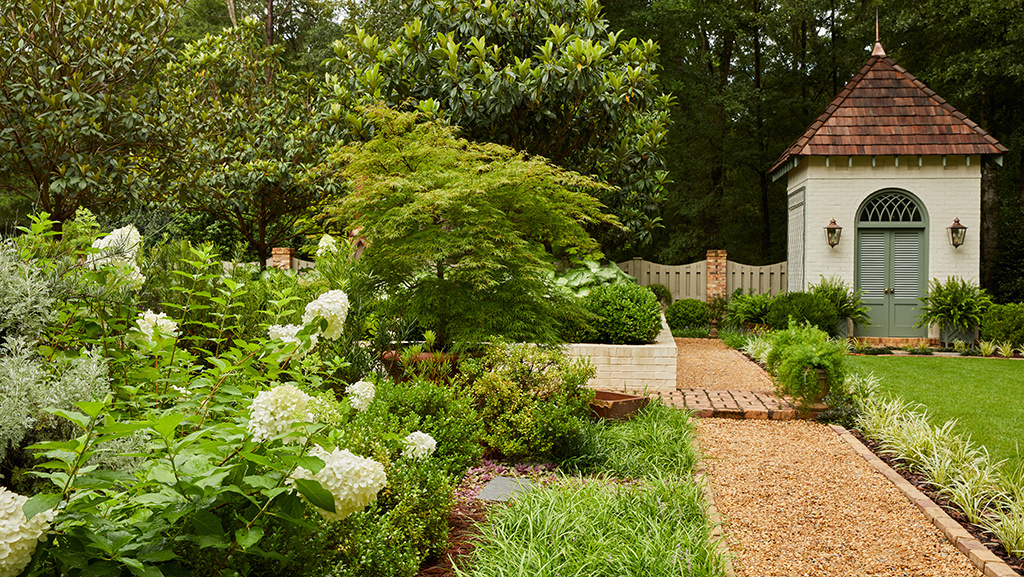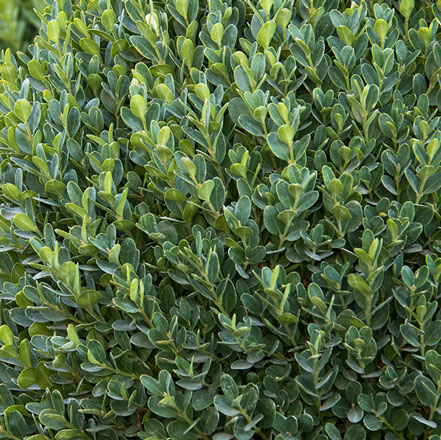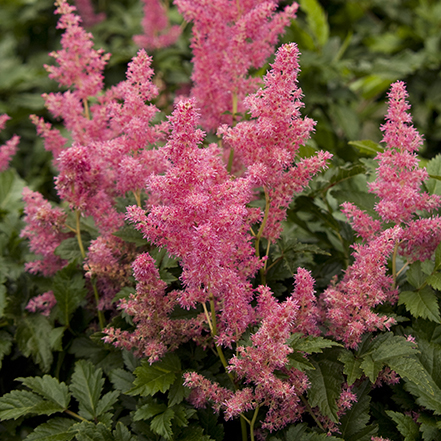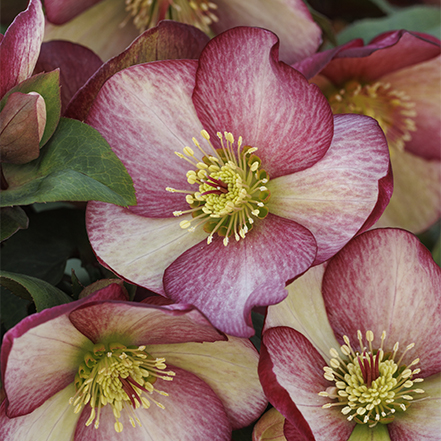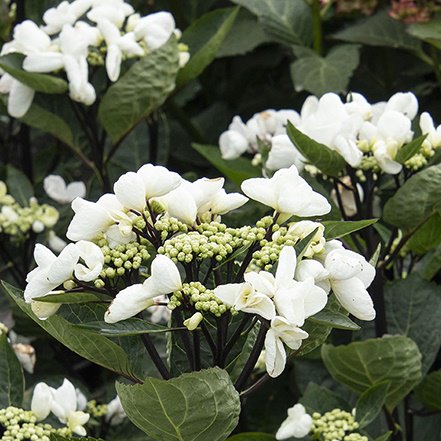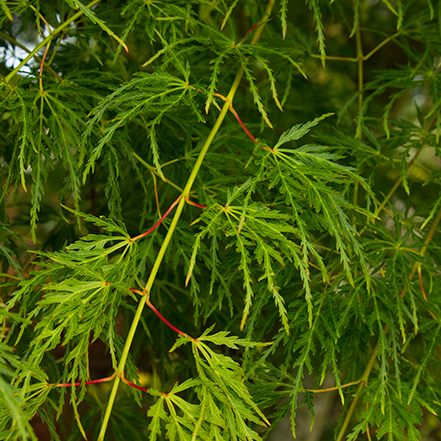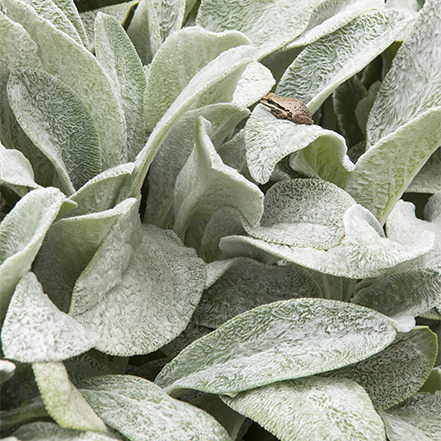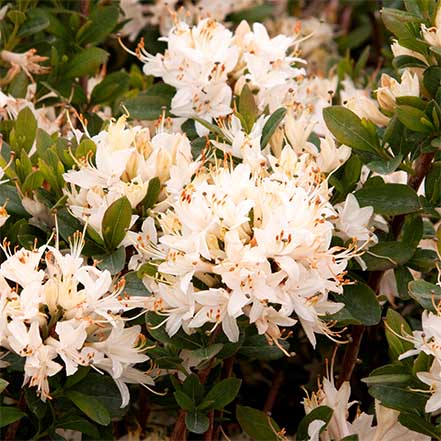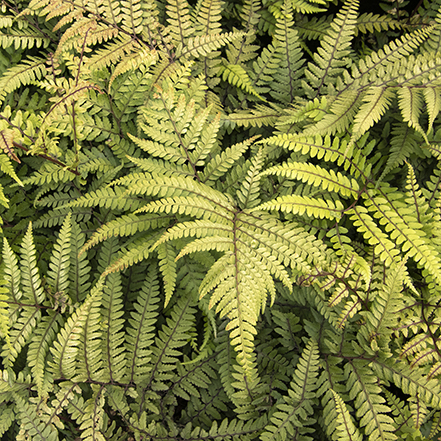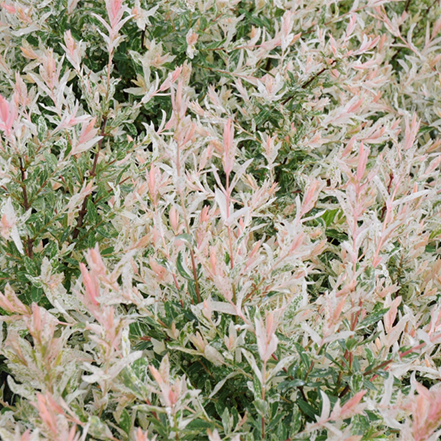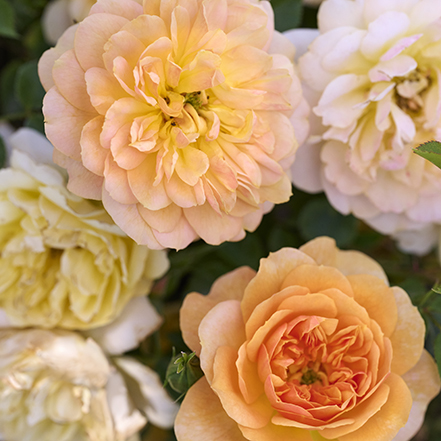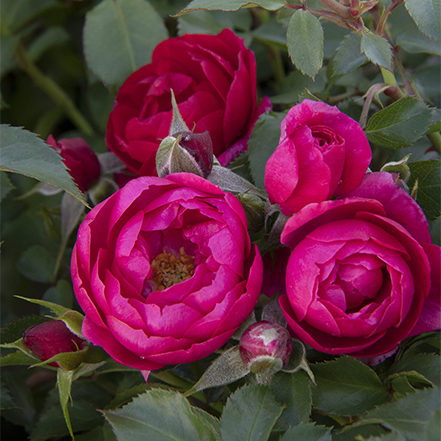What is a "romantic" garden? Is it something storybook, blowsy and cottage-y tumbling with roses, hydrangeas and swaths of perennials? Yes, of course, but is that too narrow a definition? Could a "garden of romance" mean something entirely different to different kinds of gardeners? Could your modern garden be "romantic?" How about your potagers and vegetable patches?
(Above) Japanese maple, Limelight hydrangea, and a border of sedge line a gravel path that leads to a garden "shed" flanked by containers of wood fern.
We needed answers, so we turned to James Farmer. James is a renowned author and designer whose own Georgia garden, lovingly referred to as "Farmdale," is a study in leafy and flowery seduction. We asked him if "romantic" was a style or a sensibility? "When it comes down to it," he says, "I create outdoor spaces where people live and sleep and eat and love and kiss goodnight, and that is romantic."
The Farmdale garden is centered around a walled parterre with a classic configuration of four symmetrical beds that surround a center circle. The formal symmetry is a juxtaposition to the semi-casual plantings within.
Read on to take a tour of not only Farmdale, but the rustically romantic Joe Pye Cottage in the mountains of North Carolina. Get James's top tips and must-have plants for creating a romantic garden along the way.
What is a parterre garden?
A parterre is a formal, symmetrical garden design with geometric patterns of clipped hedges and low plantings, typically arranged in grids or other shapes. They often feature colorful flowers, herbs, or shrubs within defined sections that are separated by pathways.
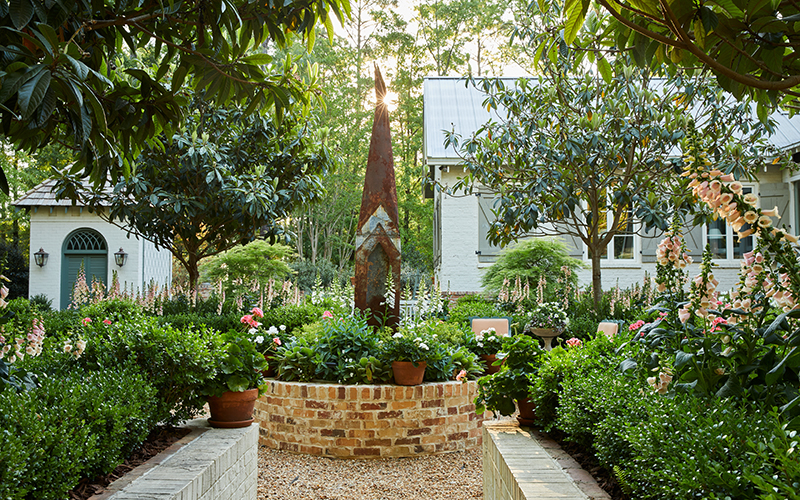
(Above) A view of the garden obelisk in summer when the showy spikes of foxgloves are in full bloom. Notice the subtle contrast of the grey brick walls of the four beds against the aged red bricks of the center feature. Clipped boxwoods are a unifying plant throughout the space. Tucked into all of this are James's four favorite fragrant plants: Sweet Osmanthus (a.k.a tea olive), rosemary, mint, and magnolia.
Trending: The Garden of Romance
The "Garden of Romance" is one of our top garden trends for 2024. What that means is evolving as climate change, earlier springs, shorter winters, and the cadence of our busy lives impact plant choices. (Learn more about the newly updated USDA Plant Hardiness Zone Map and what that might mean for you here).
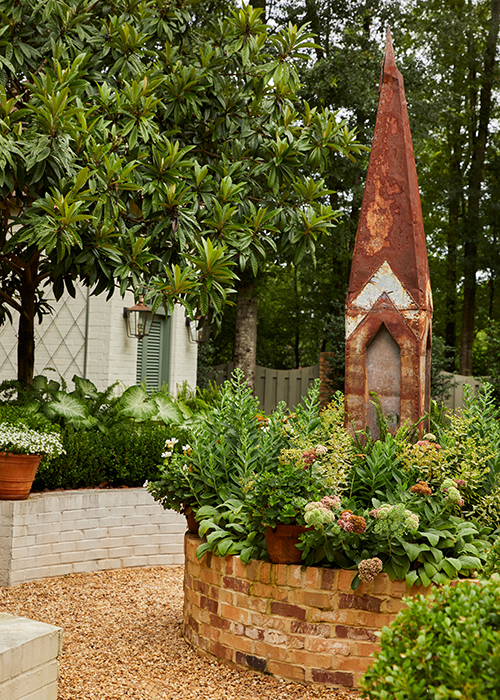
(Above) As fall approaches, the garden's continued reliance on a disciplined color palette shows in the Autumn Joy sedum that works so perfectly with the reddish patina of the church steeple centerpiece. Sparkling white verbena and white-ribbed caladium bring light to the space.
Where once a labor-intensive cottage garden with abundant flowering perennials in a lusty sort of exuberant jumble would have been the exemplar of the style, the romantic trend has adapted to fit our modern times. Still think big, beautiful blooms and softer colors, but with the benefit of modern breeding that has made these plants easier to grow. Flowering trees and shrubs also provide a bounty of blooms with less planting and maintenance.
James's Farmdale garden is an excellent example of planting for this romantic style and this decade. He uses a leafy backbone of evergreen shrubs such as sheared boxwoods and Sweet Osmanthus, flowering trees such as magnolia, and interesting forms such as softly cascading Japanese maples, topiary roses, and billowing grasses do the hard work in the space.
Each of these would be pretty romantic on their own but gathered together, they perform long-season magic. Plus, they allow for short-season delights, such as his foxgloves and geraniums, to shine.
James Farmer's Must-Have Romantic Garden Elements
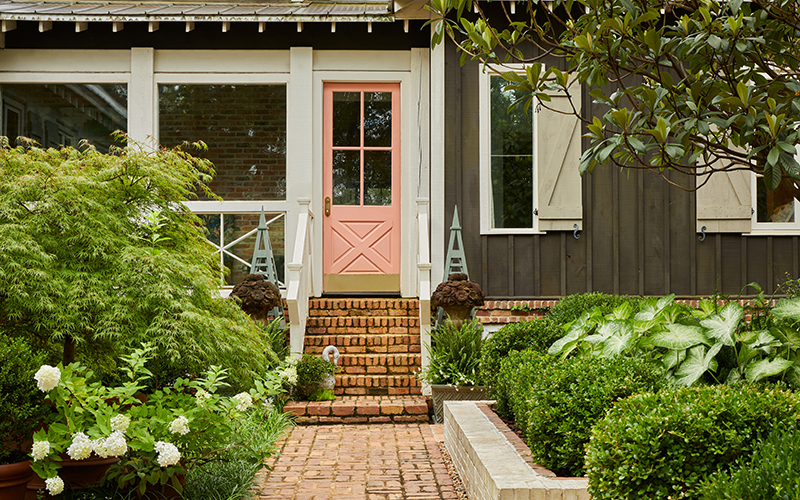
(Above) Adding a pop of soft pink to the back door sets the tone for the garden experience. Hydrangeas, boxwoods, caladium, and a fine-textured Japanese Maple soften the brick walkway. A Magnolia once again frames the view.
Do you love James's "rooted in tradition, but with a twist" garden style? Here's just some of his advice for growing a romantic garden with a timeless quality.
1. Plant what you love (and then plant plenty of them)
Part of the secret as to why his garden looks so cohesive while still retaining a touch of wild, is his adherence to a limited number of varieties planted en masse. It may sound obvious but by planting only what he loves to look at (James loves his Nitty Gritty™ White Rose) or what serves a specific purpose (like shrubs to create walls, flowers for cutting, or herbs such as rosemary for cooking), he can filter out the overwhelming options available and create a garden that works for him and his busy lifestyle:
"I have been gardening my entire life. I learned from my grandfather. People see my work and say "You are such a good gardener," but really I just learned to toss what didn’t grow well. If I find something that grows successfully without too much help from me, I plant in mass. That is how I got to be a “good gardener”.
2. Structure Sets the Scene for Romance
In this garden, for every showstopper, there are two backbone plants. This is a good ratio to consider when you are creating a new garden or rethinking an existing one. Want your roses to really pop? Layer them against a group of boxwoods. Contrast your stunning Japanese maple with stalwart conifers. But it all starts with a plan.
"I started off with an idea for a romantic old style garden with loads of plants, but then I had to strip it back to make the systems of the garden work. The place needed drainage and bones to create rooms. This exercise in thoughtful planning before digging translates to my limited plant palette. I will plant 100 of one thing and that continuity helps to create the structure," he says.
3. Scent and Sensuality
"What's that delicious scent?" Garden visitors are often asking about delightful smells because James relies heavily on plants with lots of sweet or spicy fragrances to draw visitors to different sections of his space. One well-placed rose or flowering magnolia can have a Siren-like effect, prompting you to explore the garden by searching for the source.
He also plays with the effect of foliage throughout the day, such as Lady's Mantle which is all dewy in the morning, or the way lambs' ears silver foliage gleams in the moonlight. And of course, cultivating a sense of wild abandonment even in his structured garden by letting plants such as ferns, cosmos, larkspur, and globe amaranth go wild and au naturale.
The modern romantic garden combines the magic of old-fashioned plants with a more crisp and modern structure. Take a page from James's garden and find the right balance in your space.
4. The Element of Surprise
"A garden, like a house's interior, is not really yours until you make it your own," says James. And that means adding things you love and introducing the discovery and surprise.
While this could be anything, a case in point here is the metal sculpture set central to his space. "I didn’t go to a store looking to buy a church steeple. I found mine by driving down the street one day, saw it on a curb outside of a church, and paid a guy 20 bucks to put it into my car. "
A romantic garden (like a wonderful home) is built over time with layers and layers of delightful elements that tell your story. The same goes for plants. James is always on the hunt. "When I see a roadside stand that has cool plants, I will always stop because you just never know what you will find. When you are a gardener, you never turn it off!"
A Complement of Opposites
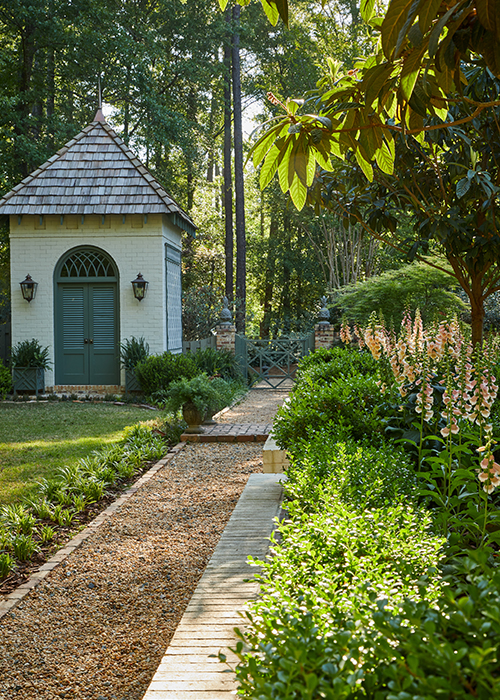
(Above) James doesn't have a lot of lawn in his garden but with kids and dogs, the minimal turf is put to good use. The boxwoods and foxgloves found in the parterre continue here for a seamless look. Love the color of those gates and doors? It's Greenish Gray by Valspar (Sherwin Williams Rosemary is a close equivalent).
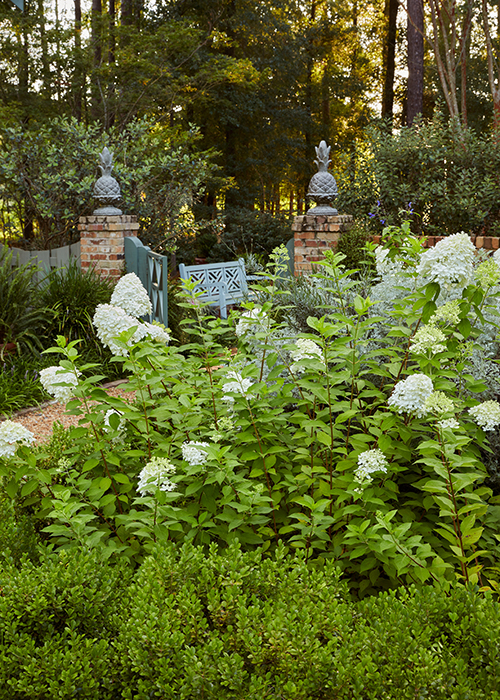
(Above) As you approach the gate from the pathway you once again see the aged red brick that is in the center part of the parterre. More boxwoods and hydrangeas thrive in the dappled light as you get nearer to the wood area beyond. An inviting lattice-back painted bench is positioned to take it all in while getting out of the bright Georgia sun.
The Farmdale garden is a series of rooms navigated by crisply-edged gravel paths and plenty of hidden corners. It is a garden that does not show all of its romantic moments right away.
As you move through the space, you are one minute eyeing deep and lush sunny borders, and with a turn, you see a gate leading to a forested area waiting to be explored (this garden is set on 3 acres and is part of a 80-acre parcel owned by James' family).
The yin-yang of disciplined disorder within the same space keeps your eye moving and your senses on full alert. You can never get too comfortable in a garden with this many surprises.
"Romance is a complement of opposites," says James. "It is the mix and juxtaposition that creates a paradox, and a garden is where these worlds collide. A bit of beauty that nature and man make together."
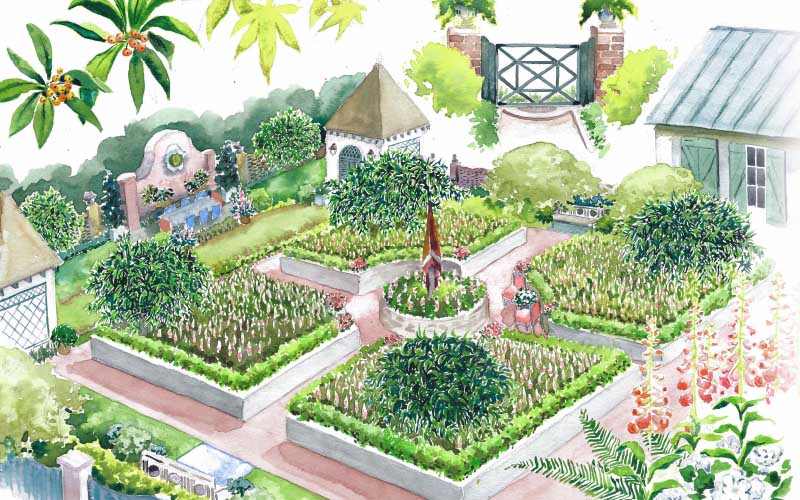
Illustration by Emmie Ruth Wise
Get the "Garden of Romance" Look with These Plants
Petite Pillar™
Dwarf Boxwood
Slow-growing dwarf boxwood with evergreen foliage that's easily clipped into formal topiary shapes. Use in borders, accenting a corner or pots. Up to 3" tall. Zones 5 - 9.
Rheinland
Astilbe
Tall, feathery, clear pink blooms rise above the mound of lush green foliage, adding a light, airy quality to borders or mass plantings. Partial shade. Up to 2' tall and wide. Zones 4 - 9.
Ice N' Roses®
Rosado Hellebore
New hybrid with blooms facing outwards, and even upwards, to greet the spring. Cool-season bloomer. Lovely in a woodland setting. Partial shade. Up to 2' tall and wide. Zones 5 - 9.
Grace N' Grit™ Pink
BiColor Shrub Rose
Pink and white bicolor roses on a fuss-free shrub that will endure the trials of a long, hot summer with an unwavering blooming zeal. Full sun. Up to 5' tall. Zones 4 - 9.
Seaside Serenade®
Glacier Bay Hydrangea
Repeat blooming variety with loads of brilliant white lacecap flowers on dramatic black stems all summer into fall. Partial shade. Up to 3' tall and wide. Zones 4 - 9.
Seiryu Japanese Maple
Upright, vase-shaped form displays finely dissected lacy green foliage. Lovely red fall color. Makes an attractive garden or patio tree. Full sun to partial shade. Up to 15' tall, 8' wide. Zones 5 - 8
Big Ears
Lamb's Ear
Attractive silver-green foliage which forms a dense groundcover of thick, soft, velvety rosettes. Highly prized for its foliage. Full to partial sun. Up to 12" tall, 24" wide. Zones 4 - 9.
Fragrant Star
Azalea
Named for extremely aromatic, large, five-petaled, snowy white flowers that top blue-green foliage. Relatively cold hardy and heat tolerant for an azalea. Full to partial sun. Up to 5' tall, 4' wide. Zones 5 - 9.
Jurassic™ Pterodactyl
Eared Lady Fern
Airy, feathery texture from pale green fronds unfurling from red stems. Two-toned look with the older, dark-green foliage. Full to partial shade. Up to 18" tall and wide. Zones 6 - 9.
Bonus: The Rustic Romance of Joe Pye Cottage Garden
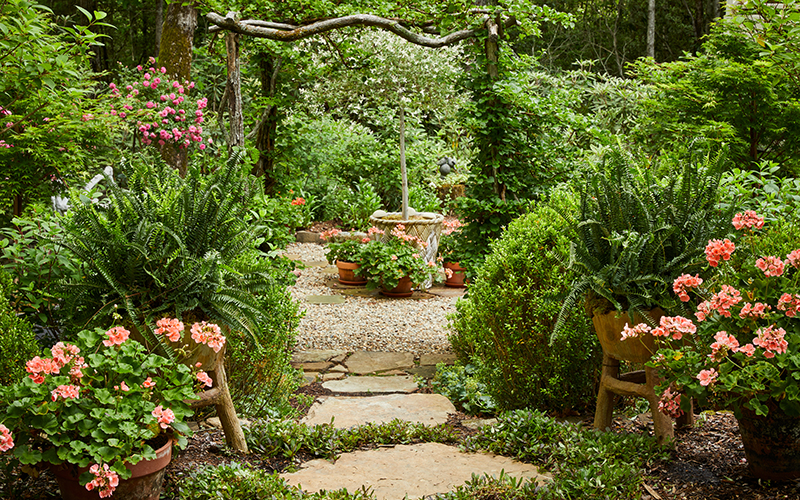
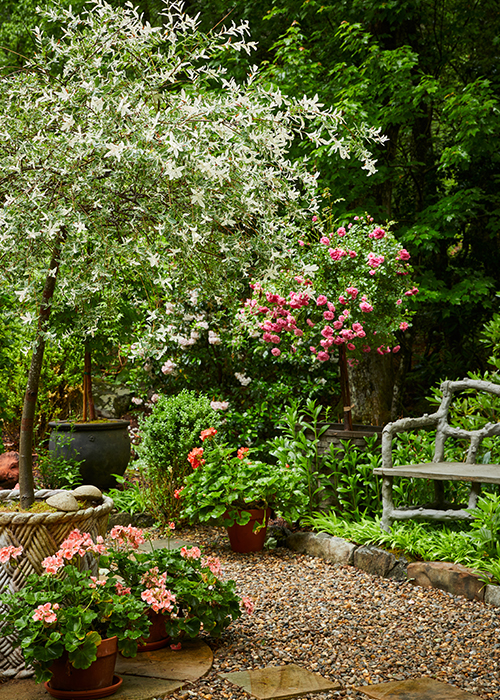
A shimmery dappled willow in a large pot surrounded by tidy boxwoods, ferns, and vines sets a mood of rustic romance in James' "Joe Pye Cottage" garden, which is tucked into the woods of the Chilhowee Mountain Ridge in Cashiers, North Carolina.
The central feature is an arbor made from fallen branches, a classic garden element in this part of North Carolina. The arbor syncs perfectly with the forest beyond, as does the bent-wood-inspired stone bench to the side. In the rear, as we move out of this space into the woods, we see native azaleas that bloom in spring.
The willow is surrounded by potted annuals but if you have a larger pot, James offers this "recipe" for planting under the tree in a semi-shaded space: lamb's ear, Diamond Frost euphorbia, heuchera and lamium.
Get the Look with These Plants
Flamingo
Dappled Willow
Fantastic variegated foliage of pink, white, and bright apple green on an easy-care shrub or tree form. Foliage resists heat scorch and stands up to rain and wind. Part to full sun. Up to 10' tall and wide. Zones 4-10.
Itsy Bitsy® Peach
Miniature Rose
A darling little rose that is perfect in the garden or in containers. It blooms in abundance throughout the growing season, with small deep yellow and orange blooms with light blushes of pink. Has excellent resistance to mildew and rust. Full sun. Up to 18" tall, 24" wide. Zones 5-9.
Nitty Gritty™
Pink Rose
This very durable, own-root, fuss-free groundcover rose produces an abundance of lovely blooms while offering excellent disease resistance and a self-cleaning, easy-to-care-for habit. Get the patio tree form for a similar look to the rose tree pictured above. Full sun. Up to 3' tall, 4' wide. Zones 4-9.
Need More Options?
Meet the Designer
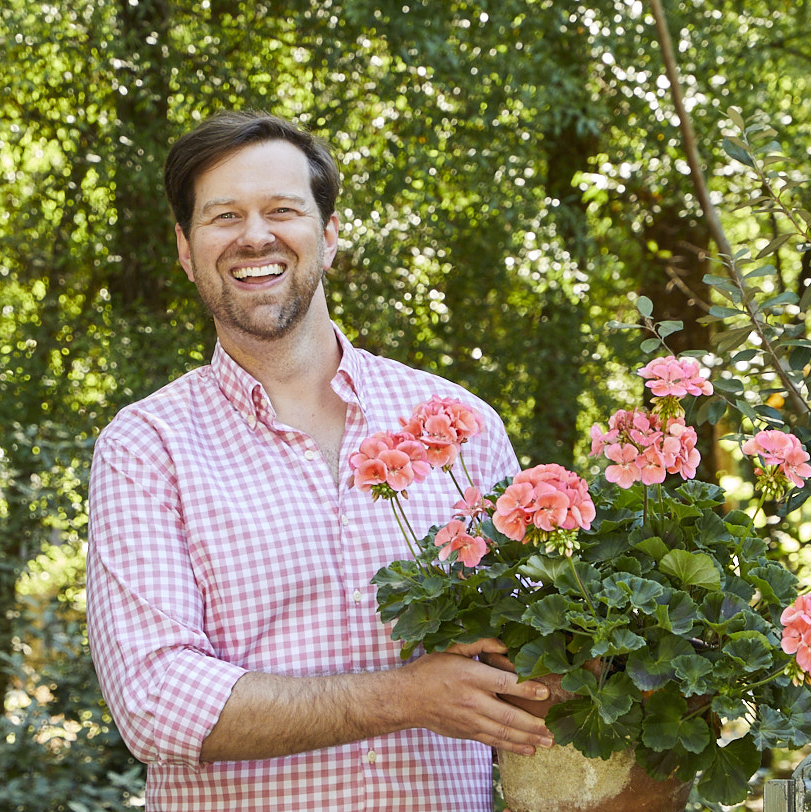
James Farmer is a Southern author, interior designer, and speaker known for his ability to create beautifully familiar and welcoming homes. He is the author of the Wall Street Journal best-selling books A Time to Plant; Sip & Savor; Porch Living; Wreaths For All Seasons; A Time To Cook; Dinner on the Grounds; A Time to Celebrate, A Place to Call Home and Arriving Home. His most recent publication, Celebrating Home, showcases thedetails and beauty of celebrating life’s special moments.
